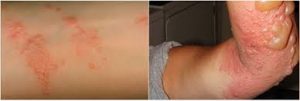 Urushiol is an oily mixture of organic compounds with allergenic properties found in plants of the family Anacardiaceae, especially Toxicodendron spp. (e.g., poison oak, poison ivy, poison sumac), parts of the mango tree as well as the fruit of the cashew tree.
Urushiol is an oily mixture of organic compounds with allergenic properties found in plants of the family Anacardiaceae, especially Toxicodendron spp. (e.g., poison oak, poison ivy, poison sumac), parts of the mango tree as well as the fruit of the cashew tree.
In most individuals, urushiol causes an allergic skin rash on contact, known as urushiol-induced contact dermatitis.
Less than half of the general population experience a reaction with the saturated urushiol alone, but over 90% do so with urushiol that contains at least two degrees of unsaturation or double bonds.
Longer side chains tend to produce a stronger reaction.
Urushiol is an oleoresin.
It is contained within the sap of poison ivy and related plants.
Following an injury to the plant, or late in the fall, the sap leaks to the surface of the plant, where under certain temperature and humidity conditions the urushiol becomes a blackish lacquer after being in contact with oxygen.
Urushi lacquer is very stable: withstands disturbances from alkali, acid, and alcohol, while also being able to resist temperatures of over 300 °C.
The lacquer can be degraded by UV rays from the sun.
Poison ivy can be found in all states except California, Alaska, and Hawaii.
Poison Oak can be found on the west coast or in some states in the southeast, while poison sumac can be found only in the eastern half of the country.
Poison ivy always grows with groups of three glossy, pointed leaflets.
Poison oak has a similar appearance, but with larger and more rounded lobes, with a light, velvety pubescence and grow in groups of 3, 5, or 7.
Poison sumac grows in groups of 7 to 13 leaflets, always an odd number. The leaflets are ovate-lanceolate and glossy.
Before the urushiol has been absorbed by the skin, it can be removed with soap and water, but substantial amounts of urushiol may be absorbed within minutes.
After absorption by the skin, urushiol is recognized by the immune system’s dendritic cells.
These cells then migrate to the lymph nodes, where they present the urushiol to T-lymphocytes and thus recruit them to the skin, and the T-lymphocytes cause pathology through the production of cytokines and cytotoxic damage to the skin.
This causes the painful rash, blisters, and itching.
Cortisone/prednisone, are effective.
Medications that can reduce the irritation include antihistamines.
Other treatments include applying cold water or calamine lotion to soothe the pain and stop the itching.
Allergic dermatitis reaction is caused by urushiol being first oxidized to creating two double-bonded oxygens on the chemical, which reacts with a protein nucleophile to trigger a reaction within the skin.
Dermatitis is mediated by an acquired immune response.
Urushiol attaches to certain proteins of the skin, where it acts as a hapten, leading to a type IV hypersensitivity reaction.
Hydrocortisone stops the release of chemicals that cause the dermatitis reaction.
Hydrocortisone itself does not react with urushiol in any way.
